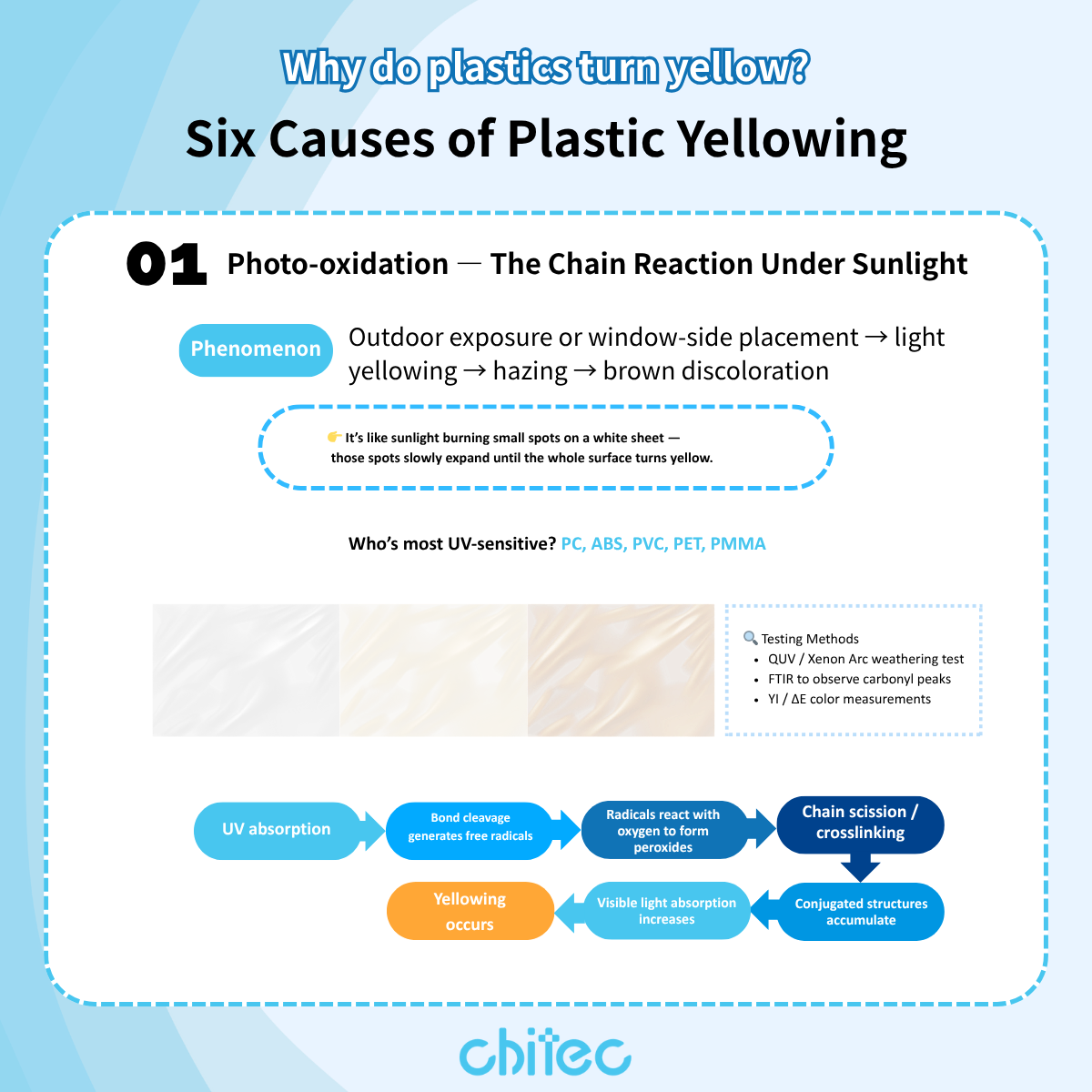📘 Six Causes of Plastic Yellowing
Part 1: Photo-oxidation — A Chain Reaction Under Sunlight

🌤 A Classic Example
The most common case is plastic exposed outdoors or placed near a window. It starts with a faint yellow tint, gradually becomes hazy, and eventually darkens into a brownish color over time. Transparent parts are particularly sensitive — even a subtle shift in hue is easily noticeable to the human eye.
⚗️ Core Mechanism: A Chemical Script Triggered by a Single Photon
- UV Absorption: Plastic molecules may contain reactive sites — such as double bonds (C=C), carbonyl groups (C=O), aromatic rings, or residual metal catalysts. These structures absorb UV light, exciting the molecule to a higher energy state.
- Free Radical Formation: Once excited, some molecular bonds break, creating highly reactive free radicals (R•). This often occurs via Norrish I or II reactions, particularly in carbonyl-containing systems like PET bottles or PC light covers.
- Reaction with Oxygen: Free radicals rapidly capture oxygen to form peroxy radicals (ROO•), which further convert into hydroperoxides (ROOH).
- Decomposition and Propagation: Under light or heat, ROOH decomposes, leading to chain scission (shorter polymer chains) and generating new double bonds and carbonyl groups. Once conjugated structures form, they absorb visible light — resulting in a yellow or brown appearance.
🔍 Further Insight: UV Light & Testing Methods
UV isn’t just from sunlight. Indoor sources — fluorescent lamps, UV LEDs, curing systems, and even display lighting — can also emit UV rays that quietly accelerate yellowing.
How to simulate sunlight in the lab? To evaluate weatherability, laboratories use QUV or xenon arc testers to mimic sunlight and weather conditions.
・QUV testing: Typically uses UVA-340 or UVB-313 lamps to simulate sunlight’s UV spectrum.
・Xenon testing: Provides a broader simulation including UV and visible light.
🎨 How to Tell If the Material Has Yellowed
Researchers use FTIR spectroscopy to detect carbonyl absorption peaks (around 1715–1730 cm⁻¹), indicating oxidation.
Color change is tracked by Yellowness Index (YI) or CIE L*a*b* color system. A higher ΔE* value means a more noticeable color shift.
👉 In short, plastic aging can be scientifically measured — it’s not just about “eyeballing” the yellowing process.
📘 Stay tuned for the next five chapters in our “Plastic Aging Mechanisms” series to explore the chemistry behind yellowing, embrittlement, and gloss loss.
Read more –
Six Causes of Plastic Yellowing Part 2: Thermal Oxidation
Six Causes of Plastic Yellowing Part 3: The “Side Effect” of Antioxidants
Six Causes of Plastic Yellowing Part 4: Additives and Impurities
Six Causes of Plastic Yellowing Part 5: Gas Fading
Six Causes of Plastic Yellowing Part 6: Inherent Aging Characteristics of Materials
The Science of Stability: How UV Absorbers Extend Material Performance
🔹 Chitec Technology | The Expert in Anti-Aging Solutions for Materials

建議您使用以下瀏覽器觀看本網站,
要下載瀏覽器,請直接點擊以下:以獲得最佳瀏覽效果。